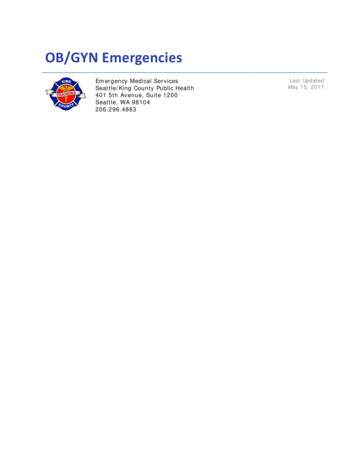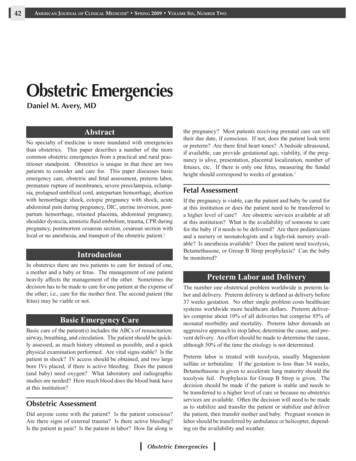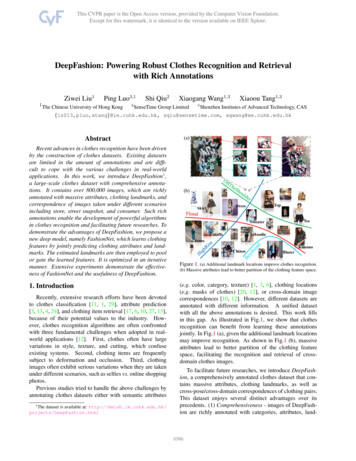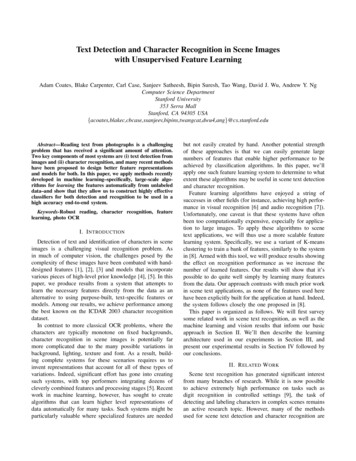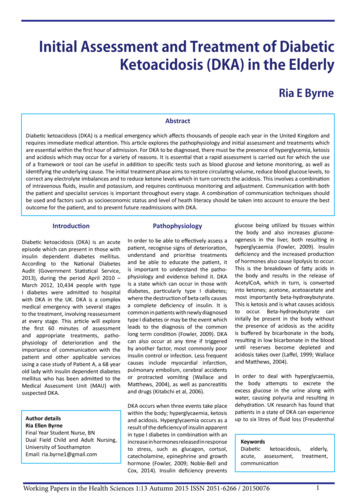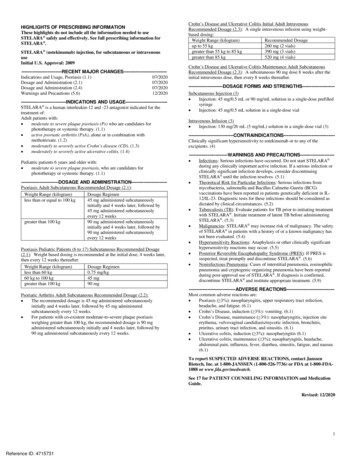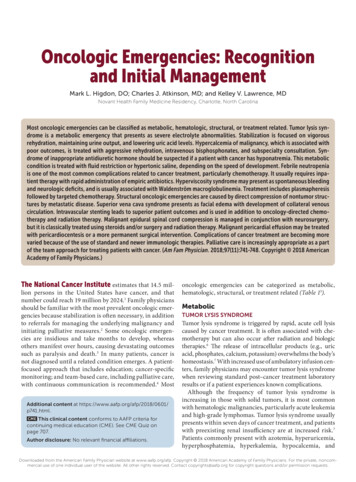
Transcription
Oncologic Emergencies: Recognitionand Initial ManagementMark L. Higdon, DO; Charles J. Atkinson, MD; and Kelley V. Lawrence, MDNovant Health Family Medicine Residency, Charlotte, North CarolinaMost oncologic emergencies can be classified as metabolic, hematologic, structural, or treatment related. Tumor lysis syndrome is a metabolic emergency that presents as severe electrolyte abnormalities. Stabilization is focused on vigorousrehydration, maintaining urine output, and lowering uric acid levels. Hypercalcemia of malignancy, which is associated withpoor outcomes, is treated with aggressive rehydration, intravenous bisphosphonates, and subspecialty consultation. Syndrome of inappropriate antidiuretic hormone should be suspected if a patient with cancer has hyponatremia. This metaboliccondition is treated with fluid restriction or hypertonic saline, depending on the speed of development. Febrile neutropeniais one of the most common complications related to cancer treatment, particularly chemotherapy. It usually requires inpatient therapy with rapid administration of empiric antibiotics. Hyperviscosity syndrome may present as spontaneous bleedingand neurologic deficits, and is usually associated with Waldenström macroglobulinemia. Treatment includes plasmapheresisfollowed by targeted chemotherapy. Structural oncologic emergencies are caused by direct compression of nontumor structures by metastatic disease. Superior vena cava syndrome presents as facial edema with development of collateral venouscirculation. Intravascular stenting leads to superior patient outcomes and is used in addition to oncology-directed chemotherapy and radiation therapy. Malignant epidural spinal cord compression is managed in conjunction with neurosurgery,but it is classically treated using steroids and/or surgery and radiation therapy. Malignant pericardial effusion may be treatedwith pericardiocentesis or a more permanent surgical intervention. Complications of cancer treatment are becoming morevaried because of the use of standard and newer immunologic therapies. Palliative care is increasingly appropriate as a partof the team approach for treating patients with cancer. (Am Fam Physician. 2018;97(11):741-748. Copyright 2018 AmericanAcademy of Family Physicians.)The National Cancer Institute estimates that 14.5 mil- oncologic emergencies can be categorized as metabolic,lion persons in the United States have cancer, and thatnumber could reach 19 million by 2024.1 Family physiciansshould be familiar with the most prevalent oncologic emergencies because stabilization is often necessary, in additionto referrals for managing the underlying malignancy andinitiating palliative measures.2 Some oncologic emergencies are insidious and take months to develop, whereasothers manifest over hours, causing devastating outcomessuch as paralysis and death.3 In many patients, cancer isnot diagnosed until a related condition emerges. A patientfocused approach that includes education; cancer-specificmonitoring; and team-based care, including palliative care,with continuous communication is recommended.4 MostAdditional content at https:// w ww.aafp.org/afp/2018/0601/p741.html.CME This clinical content conforms to AAFP criteria forcontinuing medical education (CME). See CME Quiz onpage 707.Author disclosure: No relevant financial affiliations.hematologic, structural, or treatment related (Table 15).MetabolicTUMOR LYSIS SYNDROMETumor lysis syndrome is triggered by rapid, acute cell lysiscaused by cancer treatment. It is often associated with chemotherapy but can also occur after radiation and biologictherapies.6 The release of intracellular products (e.g., uricacid, phosphates, calcium, potassium) overwhelms the body’shomeostasis.7 With increased use of ambulatory infusion centers, family physicians may encounter tumor lysis syndromewhen reviewing standard post–cancer treatment laboratoryresults or if a patient experiences known complications.Although the frequency of tumor lysis syndrome isincreasing in those with solid tumors, it is most commonwith hematologic malignancies, particularly acute leukemiaand high-grade lymphomas. Tumor lysis syndrome usuallypresents within seven days of cancer treatment, and patientswith preexisting renal insufficiency are at increased risk.7Patients commonly present with azotemia, hyperuricemia,hyperphosphatemia, hyperkalemia, hypocalcemia, andDownloadedthe AmericanFamily 11Physician website at www.aafp.org/afp.Copyright 2018 American Academy of FamilyPhysicians.For theprivate, noncom VolumeJune 1, 2018from97, rcial use of one individual user of the website. All other rights reserved. Contact copyrights@aafp.org for copyright questions and/or permission requests.
ONCOLOGIC EMERGENCIESTABLE 1Summary of Oncologic EmergenciesConditionCancer associationCommon presenting signsand symptomsConsultationconsiderationsMetabolicTumor lysissyndromeHematologic malignancies,particularly acute leukemia,and high-grade lymphomas; solid tumorsAzotemia, hyperphosphatemia, hyperkalemia, hyperuricemia, acute renal failure,hypocalcemiaOncology, nephrology, palliative careHypercalcemia ofmalignancyMultiple myeloma; breastcancer; squamous cell carcinoma of the head or neck,lung, kidney, or cervixProgressive decline in mental function,weakness, anorexia, thirst, constipation,nausea, vomiting, decreased urine output,possible comaOncology, endocrinology,nephrologySyndrome ofinappropriate antidiuretic hormoneSmall cell lung cancerHyponatremia, nausea, vomiting, constipation, muscle weaknessOncology, nephrology, palliative careFebrile neutropeniaCurrent chemotherapySingle axillary/oral temperature 101.3 F(38.5 C) or sustained temperature 100.4 F(38 C) for one hour, and an absolute neutrophil count 500 cells per mm3Oncology, infectiousdisease, palliative careHyperviscositysyndromeWaldenström macroglobulinemia (10% to 30%), leukemia,multiple myelomaSpontaneous bleeding, shortness of breath,neurologic deficits (peripheral neuropathies), “sausage-like” hemorrhagic retinalveins, serum viscosity 4 cPHematology, oncologySuperior vena cavasyndromeLung cancer, lymphoma,metastatic mediastinaltumors or lymph nodes,indwelling venous cathetersFacial edema, cough, dyspnea at rest,hoarseness, chest and shoulder pain, collateral venous circulation (chest wall)Oncology, cardiothoracicsurgery, palliative careMalignant epidural spinal cordcompressionBreast cancer, multiplemyeloma, lymphoma, lungand prostate cancersNew-onset back pain (worse when lyingdown), paraplegia (late presentation)Oncology, neurosurgery,palliative careMalignant pericardial effusionsLung, esophageal, and breastcancers; lymphoma; leukemia; melanoma; infection; treatment complication; autoimmune reactionDyspnea, chest pain, or palpitations; pulsus paradoxus; Beck triad (muffled heartsounds, hypotension, increased jugularvenous pressure)Oncology, cardiothoracicsurgery, palliative careChemotherapy(extravasations)Current chemotherapyPain, erythema, and swelling that progressto blanching, blistering, discoloration, andnecrosis of the skinOncology, dermatology,plastic surgeryGastrointestinalproblemsCurrent cancer treatmentAbdominal pain, nausea, vomiting, diarrhea,constipation, and dehydration; obstruction; bleeding; weight loss; dehydrationOncology, gastroenterology,general surgery, infectiousdisease, radiologyRadiation therapyCurrent radiation therapy(external, temporary internal,permanent internal, systemic)Dermatitis, cardiovascular disease, esophagitis, cystitis, sexual dysfunction, depressionOncology, dermatology,cardiology, rrent immunotherapyVague symptoms, such as flulike illness andrashOncology, targetedsubspecialtyHematologicStructuralTreatment relatedAdapted with permission from Higdon ML, Higdon JA. Treatment of oncologic emergencies. Am Fam Physician. 2006; 74(11): 1875.acute renal failure, quantified by the Cairo-Bishop definitions 7,8 (Table 2 9).Prevention and stabilization are attempted by initiating vigorous rehydration, maintaining urine output, reducing baseline uric acid levels, and limiting potassium and phosphorus742 American Family Physicianintake during high-risk periods (i.e., the three days before andthe seven days after initiation of cancer treatment).8,10 Promptreferral to an inpatient oncology team is recommended. Inthe setting of severe acute renal insufficiency, early hemodialysis can be key, necessitating nephrology referral.6www.aafp.org/afp Volume 97, Number 11 June 1, 2018
ONCOLOGIC EMERGENCIESHYPERCALCEMIA OF MALIGNANCYHypercalcemia occurs in 10% to 30% of patients with cancerand is characterized by a serum calcium level of more than10.5 mg per dL (2.63 mmol per L).11 It is most often associated with multiple myeloma and breast cancer, but is alsocommon in squamous cell carcinomas of the head or neck,lung, kidney, or cervix.12 The causes of hypercalcemia fallinto three general categories: humoral, bone invasion, andrare causes.11 Humoral causes, such as production of parathyroid hormone–related protein and increased vitamin D3,are most common (80% of cases). Hypercalcemia frombone invasion and local osteolysis by cytokines accounts forapproximately 20% of cases. Rare causes include immobilization, medications, and parathyroid carcinoma.12,13Symptoms of hypercalcemia include progressive declinein mental function, weakness, anorexia, thirst, constipation, nausea, vomiting, decreased urine output, and coma.Serum calcium measurements should always be adjustedfor albumin levels because of possible malnourishment.Prompt stabilization includes aggressive rehydration untilthere is euvolemia, followed by careful diuresis with furosemide (Lasix). Whether discovered incidentally or during thecourse of treatment, hypercalcemia in patients with cancershould prompt urgent subspecialty referral (e.g., oncology,endocrinology, nephrology). Intravenous bisphosphonatetherapy and newer monoclonal antibodies (e.g., denosumab) inhibit osteoclastic activity.14,15 Hypercalcemia ofmalignancy has a poor prognosis, with a median survival of35 days from diagnosis.8SYNDROME OF INAPPROPRIATE ANTIDIURETICHORMONESyndrome of inappropriate antidiuretic hormone (SIADH)should be suspected in patients with cancer who presentwith hyponatremia (a sodium level of less than 135 mEqper L [135 mmol per L]). Early recognition is crucial becausesevere hyponatremia is associated with poor outcomes.16Small cell lung cancer often is the ectopic source of theantidiuretic hormone production, although other tumors(head or neck) and certain chemotherapy agents (particularly vinca alkaloids, platinum compounds, and alkylatingagents) can also cause SIADH.3,17Patients with SIADH may present with gastrointestinaland neurologic symptoms. There are few physical examination findings associated with SIADH, although papilledemaand pathologic reflexes (e.g., Babinski sign) are occasionallypresent.16 Laboratory testing often reveals hyponatremia,decreased serum osmolarity, and concentrated urine.Although treating the cancer is primary, recent studiesacknowledge that aggressive treatment of the hyponatremiaitself improves patient outcomes.16,17 Fluid restriction (limitJune 1, 2018 Volume 97, Number 11TABLE 2Cairo-Bishop Definitions for TumorLysis Syndrome 2 of the following in one 24-hour period within 3 daysbefore or 7 days after the initiation of chemotherapyCalcium 7.0 mg per dL (1.75 mmol per L) or 25% decreasefrom baselinePhosphorus 4.5 mg per dL (1.45 mmol per L) in adults,6.5 mg per dL (2.10 mmol per L) in children, or 25% increasefrom baselinePotassium 6.0 mEq per L (6.0 mmol per L) or 25% increasefrom baselineUric acid 8.0 mg per dL (476 µmol per L) or 25% increasefrom baselineClinical tumor lysis syndrome is laboratory criteria fromabove plus 1 of the followingCardiac arrhythmia or sudden deathCreatinine 1.5 times the upper limit of normal for ageSeizureAdapted with permission from Cairo MS, Bishop M. Tumour lysissyndrome: new therapeutic strategies and classification. Br J Haematol. 2004; 1 27(1): 5 .to 500 to 1,000 mL per day) is an important component ofSIADH management. Slow correction of serum sodium(less than 12 mEq per L [12 mmol per L] in 24 hours andless than 18 mEq per L [18 mmol per L] in 48 hours) avoidscentral pontine myelinolysis; hypertonic saline is usedwhen hyponatremia develops rapidly.17 Newer agents suchas tolvaptan (Samsca), a selective vasopressin V2 receptorantagonist that increases free water excretion, are emerging,although there are concerns about liver injury.18 Regardless,patients presenting with severe symptoms are best managedwith oncology and nephrology referral.19HematologicFEBRILE NEUTROPENIAFebrile neutropenia is one of the most common complicationsrelated to cancer treatment, particularly chemotherapy. Thehighest-risk causative agents include anthracyclines, taxanes, topoisomerase inhibitors, platinums, gemcitabines,vinorelbine (Navelbine), and alkylating agents.3 Febrile neutropenia is associated with increased morbidity and mortality rates, and decreased quality of life.20 Bacterial infectionsare common in patients with febrile neutropenia, but fungalsources are becoming increasingly prevalent.21Signs of febrile neutropenia include a single axillary/oraltemperature of 101.3 F (38.5 C) or higher or a sustainedtemperature of 100.4 F (38 C) or higher for one hour, and anwww.aafp.org/afp American Family Physician 743
ONCOLOGIC EMERGENCIESabsolute neutrophil count (ANC) less than 500 cells per mm3or an expected decrease of ANC to less than 500 cells permm3 in the next 48 hours. Patients with cancer who presentwith fever soon after chemotherapy should receive blood cultures and inpatient treatment with empiric antibiotics untilthey are afebrile for 48 to 72 hours and ANC levels are at least500 cells per mm3 for 72 hours.22 Recent studies indicate thatemergent use of anti
01.06.2018 · oncologic emergencies can be categorized as metabolic, . surgery, palliative care Malignant epi-dural spinal cord compression Breast cancer, multiple myeloma, lymphoma, lung and prostate cancers .

